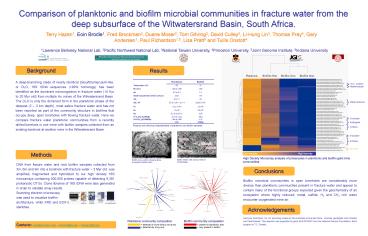Archaea - PowerPoint PPT Presentation
Title:
Archaea
Description:
Clone libraries of 16S rDNA were also generated in order to validate array results. ... detected in clone library and array = detected by array only = present ... – PowerPoint PPT presentation
Number of Views:42
Avg rating:3.0/5.0
Title: Archaea
1
Comparison of planktonic and biofilm microbial
communities in fracture water from the deep
subsurface of the Witwatersrand Basin, South
Africa.
Terry Hazen1, Eoin Brodie1, Fred Brockman2, Duane
Moser2, Tom Gihring2, David Culley2, Li-Hung
Lin3, Thomas Pray4, Gary Andersen1, Paul
Richardson1,5, Lisa Pratt6 and Tullis Onstott4.
1Lawrence Berkeley National Lab, 2Pacific
Northwest National Lab, 3National Taiwan
University, 4Princeton University, 5Joint Genome
Institute, 6Indiana University
Results
Background
A deep-branching clade of nearly identical
Desulfotomaculum-like, or DLO, 16S rDNA sequences
(gt99 homology) has been identified as the
dominant microorganism in fracture water (14 Kyr
to 20 Myr old) from multiple Au mines of the
Witwatersrand Basin. The DLO is only the
dominant form in the planktonic phase of the
deepest (2 3 km depth), most saline fracture
water and has not been reported as part of the
community structure in biofilms that occupy deep,
open boreholes with flowing fracture water. Here
we compare fracture water planktonic communities
from a recently drilled borehole in one mine with
biofilm samples collected from an existing
borehole at another mine in the Witwatersrand
Basin.
Planktonic Biofilm
Temperature (oC) 60 31
Eh (mV) -330 to -260 -250
pH 9.2 to 9.3 7.4
Depth sampled (km below surface) 2.83 1.47
CH4 9 to 17 29
SO42-/S2- 0.5 to 1.9/1.1 to 1.4 0.55/2.7x103
Fe lt 2 to 7x10-4 1.3x103
Zn lt 2x10-4 2.8x103
Ba 0.2 to 2.5x10-3 0.55
d13C-CH4 (VPDB) d2H-CH4 (VSMOW) -31.6 to -33.2 -364 to -390 mM/L -56.9 -175 mM/kg
NH3 oxidizer
Methanotroph
Metal-reducers
S-oxidizer
Acetogens
Physical and chemical characteristics of
planktonic and biofilm samples
N-fixers
S-oxidizer
Archaea
DLO-like
Methods
High intensity
Low intensity
High Density Microarray analysis of prokaryotes
in planktonic and biofilm gold mine communities.
Conclusions
Biofilm microbial communities in open boreholes
are considerably more diverse than planktonic
communities present in fracture water and appear
to contain many of the functional groups expected
given the geochemistry of an ecosystem where
highly reduced, metal, sulfide, H2 and CH4 rich
water encounter oxygenated mine air.
Acknowledgements
Harmony Gold Mine, Inc. for providing access to
the boreholes at Evander Mine. Evander
geologists Colin Ralston and Pete Roberts. This
research was supported by grant EAR-9978267 from
the National Science Foundation LExEn program to
T.C. Onstott.
Contacts tullis_at_princeton.edu elbrodie_at_lbl.gov
tchazen_at_lbl.gov

